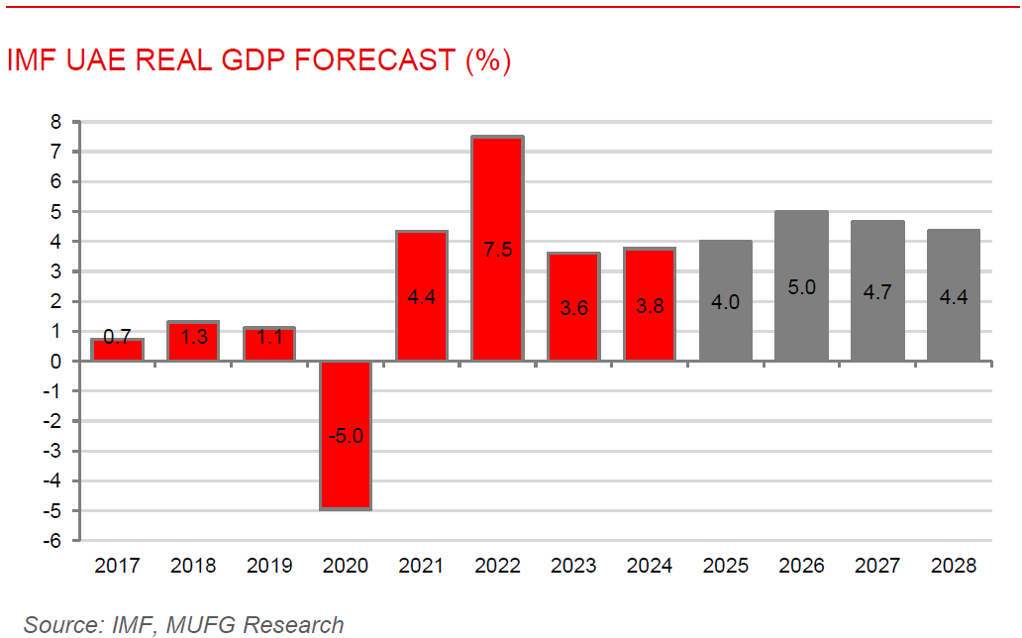To read the full report, please download the PDF above.
Middle East Daily
SOOJIN KIM
Research Analyst
DIFC Branch – Dubai
T: +44(4)387 5031
E: soojin.kim@ae.mufg.jp
MUFG Bank, Ltd. and MUFG Securities plc
A member of MUFG, a global financial group
Middle East Daily
COMMODITIES / ENERGY
Oil slips after Trump renews calls for lower prices. Oil pared back after a second weekly gain as renewed pressure from US President Trump to bring prices down and curb Russia’s war financing offset concerns from fresh Ukraine strikes on Russian refineries. Brent traded above USD67/b while WTI slipped below USD64/b, with Trump reiterating that the conflict could end if oil prices fell and urging nations to halt purchases from Russia. Despite modest weekly gains, crude remains stuck in a narrow range since early August, weighed down by bearish fundamentals including OPEC+’s accelerated output return, which has prompted the IEA to forecast a record surplus next year. Still, heightened geopolitical risks, from refinery attacks to an upcoming Trump-Xi call on trade tensions, continue to inject uncertainty into the market outlook.
Gold eases after Fed’s less-dovish tone while strong dollar weighs. Gold retreated from record highs, trading about USD60 below Wednesday’s peak after the Fed’s 25bps rate cut was accompanies by a cautious message from Chair Powell, who stressed a “meeting-by-meeting” approach to further easing. His comments strengthened the US dollar, dampening gold’s appeal for non-dollar buyers. Despite the pullback, traders still expect nearly two more cuts this year, keeping monetary easing a key driver behind gold’s 38% surge in 2025. Haven demand from geopolitical conflicts, Trump’s tariff agenda, central bank purchases, and ETF inflows have also underpinned gains. Looking ahead, political pressure on Fed independence could reinforce the rally, while elevated prices are already spurring corporate moves such as Zijin Gold International’s planned USD3.2bn IPO in Hong Kong, the largest gold sector listing since May.
MIDDLE EAST - CREDIT TRADING
End of day comment – 18 September 2025. Big spread moves today. We did already had a bit of risk on in the morning on the back of positive macro markets and the FED in the rear mirror without rocking the boat. There were inflows from ETFs and again interest in mostly duration bonds. Then came the numbers and the subsequent UST sell off. What it did was just tightening spreads as the sellers of long end bonds in the morning were happy to cover which led to some price stickiness. At some stage spreads looked 10bp tighter but then some real money selling stepped in and we close off the tights. The move overall is still substantially tighter tough, ADGB closed 5/7bp tighter, there was interest again in long end 70s which outperformed closing unch/-9bp. QATAR was less sticky and saw some selling in long end bonds in the afternoon, 48s was most active closing -0.375pt/-5bp. Quasis underperformed sovereign again, in QPETRO the afternoon had sellers of 41s closing -0.625pt/-2bp. In AD names MUBAUH remains well bid though closing 5/6bp tighter across the curve. Fins and crops had a quiet day overall without many trades. It will have to be seen if these spread levels are holding, 5/10y bonds now look completely squeezed with the odd print in a sovereign bond through UST yields (ADGB 34s today).
MIDDLE EAST - MACRO / MARKETS
UAE Central Bank lifts 2025 GDP forecast to 4.9% on oil and non-oil sector strength. The Central Bank of the United Arab Emirates has raised its 20205 GDP growth forecast from 4.4% to 4.9%, citing a boost from higher oil production under OPEC+ quotas and continued strength in the non-hydrocarbon sector. The hydrocarbon sector is projected to grow by 5.8% this year and 6.5% in 2026, while non-oil GDP, already accounting for over 77% of the UAE’s economy, is expected to expand by 4.5% in 2025 and accelerate to 4.8% in 2026. In Q1 2025 the economy grew 3.9% y/y, driven by strong gains in manufacturing, finance, construction, and real estate. The upward revision reflects both rising investment and government spending amid the country’s diversification push. Going forward, the UAE’s ability to sustain this momentum will hinge on global oil price stability, policy continuity, and non-oil sector performance.
ADIA refines private equity strategy amid global exit challenges. The Abu Dhabi Investment Authority (ADIA), which manages over USD1 trillion in assets, is recalibrating its private equity approach by deploying significant capital into secondaries, take-privates, and carve-outs, while maintaining its 12%-17% portfolio allocation to the asset class. Despite sluggish exits and tight fundraising conditions globally, ADIA reported annualised returns of 6.3% over 20 years and 7.1% over 30 years. The fund is also expanding into private credit, and this pivot forms part of ADIA’s broader transformation toward a more-data-driven model, with its quantitative research unit now employing over 125 AI, computing, and math specialists, about 10% of its workforce, underscoring its focus on agility and innovation in navigating shifting market dynamics. Overall, ADIA’s outlook is anchored in resilience, agility, and a focus on long-term value creation despite near-term uncertainties.

